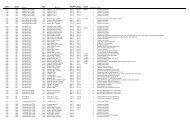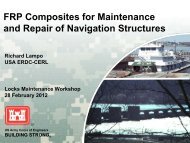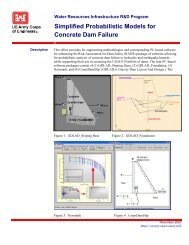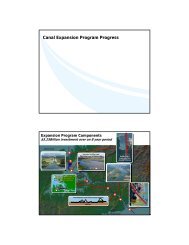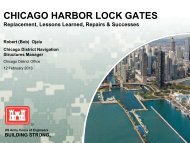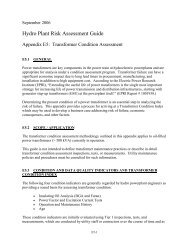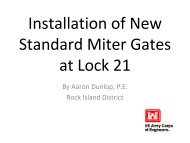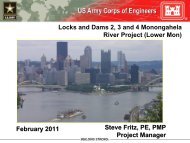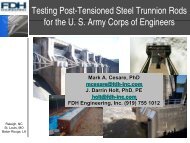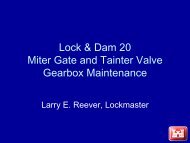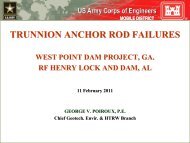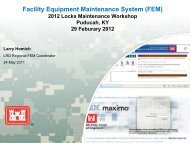Evaluation of Embedded Wall Quoin Rehabilitation ... - U.S. Army
Evaluation of Embedded Wall Quoin Rehabilitation ... - U.S. Army
Evaluation of Embedded Wall Quoin Rehabilitation ... - U.S. Army
Create successful ePaper yourself
Turn your PDF publications into a flip-book with our unique Google optimized e-Paper software.
<strong>Evaluation</strong> <strong>of</strong> <strong>Embedded</strong> <strong>Wall</strong> <strong>Quoin</strong><br />
<strong>Rehabilitation</strong> Methods<br />
Ross W. Woodbury, P.E.<br />
Navigation and Maintenance RTS<br />
Louisville District<br />
13 February 2013<br />
US <strong>Army</strong> Corps <strong>of</strong> Engineers<br />
BUILDING STRONG ®
Ground rules<br />
• ERDC funded to compare different<br />
methods for same problem for possible<br />
further application<br />
• Compared methods NOT employees<br />
• Document lessons learned for future<br />
• Compare time and cost at end <strong>of</strong> job<br />
BUILDING STRONG ®
<strong>Quoin</strong> block function<br />
• Bearing surface to transfer head<br />
differential load into the lock walls<br />
• Alignment <strong>of</strong> the embedded quoin to the<br />
gate quoin is critical<br />
• With proper adjustment the load is<br />
transferred to the wall quoin and not<br />
through the pintle<br />
BUILDING STRONG ®
Basic quoin block designs<br />
• Bearing surface flush with concrete<br />
• Bearing surface extends past concrete<br />
• <strong>Quoin</strong> block replaceable<br />
• Mainly used with horizontally framed gates<br />
BUILDING STRONG ®
Markland/Meldahl<br />
BUILDING STRONG ®
Extended wall quoin<br />
BUILDING STRONG ®
Replaceable wall quoin<br />
BUILDING STRONG ®
Common Problems<br />
• Markland and Meldahl are projects with similar designs,<br />
similar ages, and similar levels <strong>of</strong> traffic.<br />
• <strong>Wall</strong> quoins are embedded structural steel and flush with<br />
the surrounding second pour concrete. Non replaceable<br />
and not adjustable.<br />
• The project design life was 50 years.<br />
• They just hit the big five O.<br />
• Repairs with epoxies have extended service life.<br />
BUILDING STRONG ®
Different Approaches<br />
• At Markland the wall quoins were milled down for new<br />
removable replacement blocks. This required the<br />
purchase <strong>of</strong> two milling machines and replacement<br />
blocks.<br />
• At Meldahl the second pour concrete was removed along<br />
with all the embedded steel. This required a contract for<br />
a large amount <strong>of</strong> concrete removal and the purchase <strong>of</strong><br />
new embedded steel framing and new replaceable<br />
blocks.<br />
BUILDING STRONG ®
End Result<br />
• Both projects will have wall quoin blocks that are<br />
adjustable and replaceable in the future<br />
• Markland’s are stainless steel clad on the bearing surface<br />
and backed with epoxy<br />
• Meldahl’s are carbon steel and backed with zinc<br />
• Both projects will have new miter gates<br />
• Both projects will have new or refurbished anchorages<br />
• Meldahl will now have horizontal seals<br />
BUILDING STRONG ®
Markland Milling<br />
BUILDING STRONG ®
<strong>Wall</strong> <strong>Quoin</strong> Milling<br />
BUILDING STRONG ®
Milling Complete<br />
BUILDING STRONG ®
Finished <strong>Wall</strong> <strong>Quoin</strong><br />
BUILDING STRONG ®
Meldahl Concrete Removal<br />
BUILDING STRONG ®
Removed <strong>Quoin</strong> Section<br />
BUILDING STRONG ®
Concrete Removed<br />
BUILDING STRONG ®
Finished Slot<br />
BUILDING STRONG ®
New Meldahl wall quoin<br />
BUILDING STRONG ®
Markland Anchorage Work<br />
• Existing embedded anchorage reused<br />
• Heavy riveted structure analyzed for fatigue by Louisville<br />
Engineering Division. No concerns or problems found.<br />
• Anchorages were sandblasted, inspected for cracks and<br />
defects by NDT methods. Anchorages were painted and<br />
assembled using original style components but with<br />
improved material properties and inspection during<br />
fabrication.<br />
BUILDING STRONG ®
Refurbished Markland Anchorage<br />
BUILDING STRONG ®
Meldahl <strong>Embedded</strong> Anchorage<br />
• The existing concrete around the anchorage was<br />
removed and the existing structure was modified to<br />
accept a new style anchorage per Huntington District<br />
Engineering Division. This was in response to the anchor<br />
arm failure at Greenup lock.<br />
• The anchorage at Meldahl was the same as Markland.<br />
BUILDING STRONG ®
Meldahl Anchorage<br />
BUILDING STRONG ®
New Meldahl anchorage<br />
BUILDING STRONG ®
Pintle Base Modifications<br />
• Markland pintle bases were replaced to change to a<br />
fixed pintle and the existing bases were damaged when<br />
the gates fell.<br />
• Meldahl bases were modified to make the pintles fixed.<br />
BUILDING STRONG ®
Markland Pintle Base<br />
BUILDING STRONG ®
New Pintle Base<br />
BUILDING STRONG ®
Meldahl Pintle Base Modification<br />
BUILDING STRONG ®
Similarities<br />
• The heavy lift crane Shreve was used to remove,<br />
transport, and install miter gates.<br />
• Both jobs were suspended due to high water and were<br />
finished in the summer <strong>of</strong> 2012.<br />
BUILDING STRONG ®
Meldahl Advantages and<br />
Disadvantages<br />
• A - Replaces all steel and permits extra rebar and<br />
structure<br />
• A - Uses conventional equipment<br />
• A - Contractor responsible for equipment<br />
• D - Takes longer and dependant on contractor and<br />
procurement system<br />
• D - Requires Corps support for contractor<br />
BUILDING STRONG ®
Markland Advantages and<br />
Disadvantages<br />
• A - Milling is faster and retains existing embedded steel<br />
• A - No contractor involvement or coordination<br />
• D - Expensive and complicated machine to own/maintain<br />
and store<br />
• D - Doesn’t fix possible embedded issues<br />
BUILDING STRONG ®
Conclusions to wall quoin study<br />
• After the winter and high water had past<br />
work resumed on the upper gates at<br />
Markland and Meldahl.<br />
• For comparisons sake, the time required<br />
to modify the wall quoins does not include<br />
pump out or mobilization time.<br />
BUILDING STRONG ®
Greenup<br />
• The Huntington District replaced the wall<br />
quoins and gates at Greenup in 2012. This<br />
is the same work done at Meldahl except<br />
with lessons learned from Meldahl. This<br />
project gives a better comparison <strong>of</strong> the<br />
time required for the two methods.<br />
BUILDING STRONG ®
Greenup time line<br />
• 20 days to remove concrete by contractor<br />
with Corps assistance.<br />
• 10 days to install embedded steel, replace<br />
concrete, install new wall quoin blocks,<br />
and pour zinc.<br />
• The new gates were installed and adjusted<br />
after this.<br />
BUILDING STRONG ®
Markland time line<br />
• Markland lower gates: set up milling<br />
machine, mill, drill, install new blocks, and<br />
remove machine took 18 days.<br />
• Markland upper gates would have taken<br />
14 days if the one milling machine had not<br />
gotten damaged.<br />
BUILDING STRONG ®
Milling machine “problem”<br />
• At about 1 am the bolts attaching the<br />
milling machine to the vertical track broke<br />
and the machining head fell 60 ft to the<br />
bottom <strong>of</strong> the chamber and was destroyed.<br />
This resulted in a delay for investigating<br />
and to move the machine from the river<br />
wall to the middle wall.<br />
BUILDING STRONG ®
Milling machine “problem”<br />
Before<br />
After<br />
BUILDING STRONG ®
Final results<br />
• There are advantages and disadvantages<br />
<strong>of</strong> each method, however, milling is faster<br />
and cheaper, based on a fleet cost <strong>of</strong> 40k<br />
per day. The replacement blocks and bolts<br />
for Markland cost $53,000, the blocks and<br />
embedded steel for Greenup came with<br />
the new gate contract and was not priced<br />
as a separate item. I suspect over $53k.<br />
BUILDING STRONG ®
Cost comparison<br />
• Based on doing the job 10 days quicker<br />
the savings by milling would be $400,000<br />
per a set <strong>of</strong> gate leaves. The concrete<br />
removal cost for Greenup was $474,000<br />
including concrete removal for the<br />
anchorage mods. Assume half was for<br />
wall quoins, or $237,000. The total savings<br />
would be $637,000 by milling.<br />
BUILDING STRONG ®
Cost comparison (cont)<br />
• The milling machines cost $1.6 million to<br />
purchase. Assuming $100,000 per year to<br />
store and repair the machines, using them<br />
on one job each year, they would pay for<br />
themselves in 4 years (two lock<br />
chambers)compared to removing the<br />
concrete. After that you still have a unique<br />
machine that can be a Corps asset.<br />
BUILDING STRONG ®
Other considerations<br />
• If the milling machines were used in other<br />
Districts, there would be needed training <strong>of</strong><br />
that Districts employees or would require<br />
setup and operation by Louisville workers.<br />
• An accounting mechanism would need to<br />
be established. Transfer machines to<br />
PRIP Currently owned by Markland.<br />
• Close coordination <strong>of</strong> repair schedules.<br />
BUILDING STRONG ®
Questions<br />
BUILDING STRONG ®



